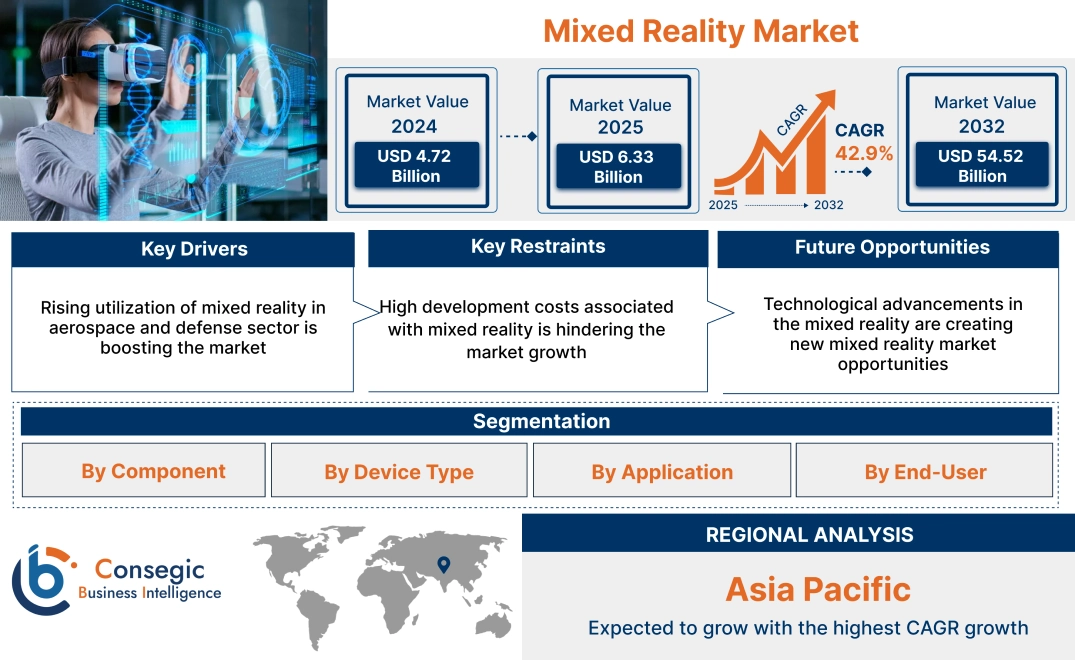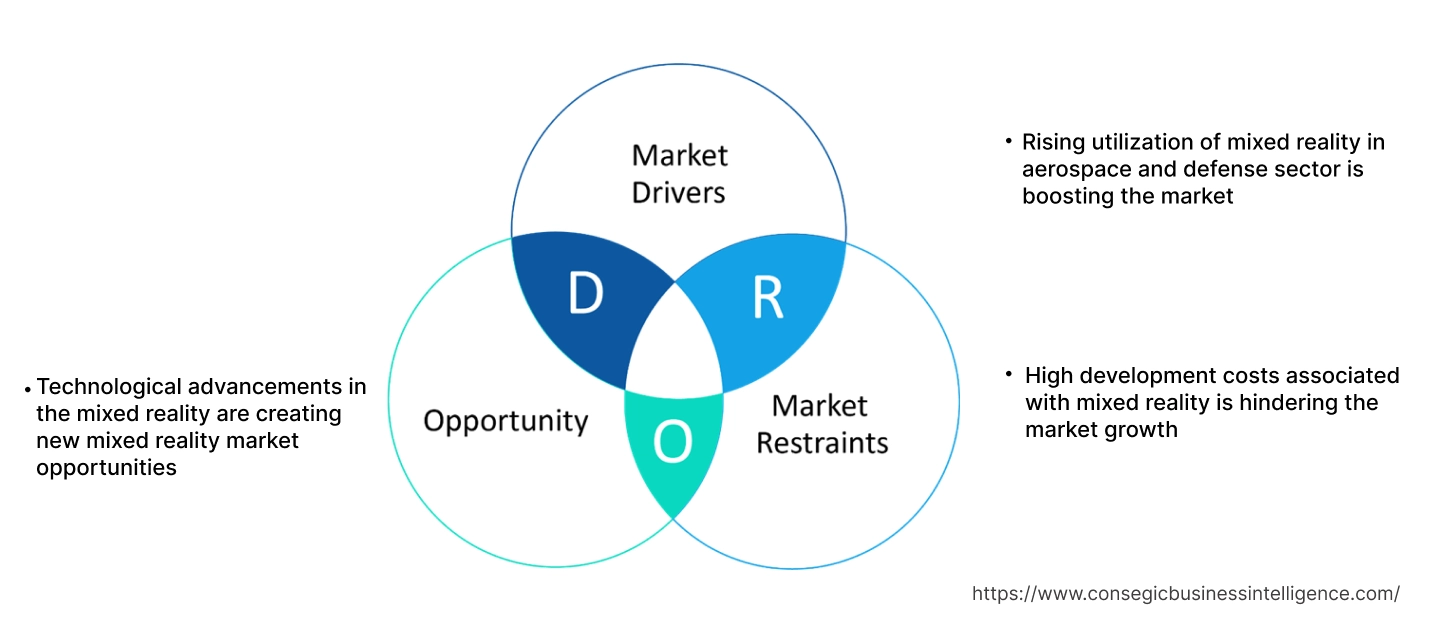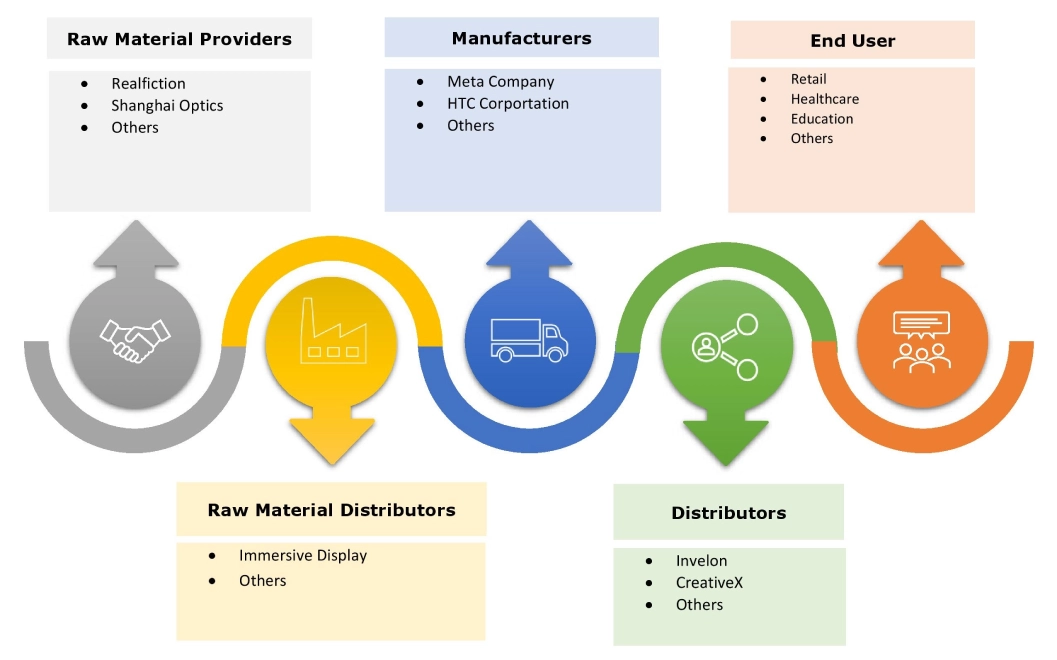- Summary
- Table Of Content
- Methodology
Mixed Reality Market Size:
Mixed Reality Market size is estimated to reach over USD 54.52 Billion by 2032 from a value of USD 4.72 Billion in 2024 and is projected to grow by USD 6.33 Billion in 2025, growing at a CAGR of 42.9% from 2025 to 2032.
Mixed Reality Market Scope & Overview:
Mixed reality (MR) is an integration of physical and virtual worlds based on advancements in graphical processing, computer vision, input systems, display technologies, and cloud computing.The use of MR technology enables the user to interact with both physical and virtual world simultaneously. MR is used for training and stimulation, virtual assistance, product design and prototyping, virtual collaboration, and others. Moreover, MR is used in various industries including healthcare, gaming, entertainment, aerospace & defense, automotive, e-commerce, retail, architecture, education, and manufacturing, among others.
Key Drivers:
Rising utilization of mixed reality in aerospace and defense sector is boosting the market
MR is used in aerospace and defense sector for creating virtual environments for pilots, technicians, and military personnel, allowing them to train the complex procedures in a safe and controlled environment. MR helps in visualizing real-world components in the virtual environment, in turn, improving safety, efficiency, and quality in design, maintenance, manufacturing, and operations.
- For instance, in March 2023, Leonardo and Varjo collaborated to enhance aircraft training using MR. Leonardo provides military training and services for operators and maintainers while Varjo provides mixed reality hardware and services.
Thus, the aforementioned factors are boosting the adoption of MR in aerospace & defense, in turn driving the mixed reality market growth.
Key Restraints:
High development costs associated with mixed reality is hindering the market growth
The development costs associated with mixed reality applications is usually high, primarily due to complex 3D modelling that requires professional and specialized skills and tools, in turn demanding for high-quality asset creation or 3D scanning, which can be time-consuming and expensive.Moreover, designing responsive user interfaces for MR applications requires considerations of hand gestures, gaze interactions, and spatial awareness, adding to the development time and costs.
Furthermore, programming for MR applications requires expertise in areas including real-time rendering, and efficient spatial computing. Thus, the market analysis shows that the aforementioned factors are restraining the mixed reality market demand.
Future Opportunities :
Technological advancements in the mixed reality are creating new mixed reality market opportunities
The technological advancements in the mixed reality corresponding to computer vision, display and optics technologies, graphic processing, and others are creating lucrative opportunities in the market. Moreover, these advancements offer various benefits including accurate spatial mapping and object recognition, project visuals onto the real world seamlessly, and rendering of realistic 3D visuals. Furthermore, advanced input systems allow spontaneous interactions with virtual objects through hand gestures or eye tracking, artificial intelligence enhances object detection, and high-speed data processing ensures smooth real-time rendering and interaction.
- For instance, in September 2023, Meta launched Meta Quest 3, a mixed reality headset using the most advanced displays and optics. It is integrated with 25 pixels per degree and 1,218 pixels per inch for the best resolution.
Thus, the ongoing technological advancements in MR are projected to drive mixed reality market opportunities during the forecast period.
Mixed Reality Market Segmental Analysis :
By Component:
Based on the component, the market is segmented into hardware and software.
Trends in the Component:
- Rising demand and adoption of advanced camera sensors to extend the scope of real-world objects is boosting the market growth.
- Increasing trend in adoption of mixed reality development platforms for use in various industries including healthcare, education, and manufacturing, among others.
The hardware segment accounted for the largest revenue share in the market in 2024.
- The hardware in MR devices can be categorized into various types including high-performance processors, advanced sensors, high-resolution displays, inertial measurement units (IMUs), and graphics processing units (GPUs), among others.
- These components are used for tracking movement, rendering 3D graphics in real-time, capturing the environment, tracking head movement, hand gestures, and eye movement, and others.
- For instance, Bosch Sensortec GmbH offers IMUs for MR, AR, and VR applications in its product offerings. These units offer maximum flexibility to users.
- Therefore, the market analysis depicts that the wide applications of hardware in MR are driving the mixed reality market growth.
The software segment is expected to register the fastest CAGR during the forecast period.
- The software in MR devices consists of mixed reality development platforms, software development kits (SDKs), cloud-based solutions, and others.
- The software enables creating simulations in healthcare and manufacturing sectors, designing visualization in engineering, creating interactive product demonstrations in retail, and enhancing remote assistance in education.
- Thus, the market analysis depicts that the aforementioned factors are boosting the mixed reality market trends during the forecast period.
By Device Type:
Based on the device type, the market is segmented into head-mounted displays (HMDs), head-up displays (HUDs), mixed reality glasses, handheld devices, and others.
Trends in the Device Type:
- Rising trend in adoption of mixed reality glasses in gaming due to immersive and collaborative experiences is driving the mixed reality market size.
- Increasing demand and adoption of handheld MR devices in retail and shopping for product visualization is boosting the market growth.
The head-mounted displays (HMD) segment accounted for the largest revenue share of 38.44% in 2024.
- The head-mounted displays are worn like glasses and project information in front of users’ eyes on the display. These displays have tracking systems to track wearer’s head position and angle.
- For instance, in September 2024, HTC VIVE launched a headset VIVE Focus Vision with 5K resolution. The headset is used for mixed reality applications, collaboration, industrial training, and location-based experiences (LBE).
- Therefore, the wide applications of HMD are boosting the mixed reality market demand.
The head-up display (HUD) segment is expected to register the fastest CAGR during the forecast period.
- The head up displays reduce distractions and allow users to consume information overlayed or projected directly into line of sight.
- Moreover, the head-up displays are mostly used in automobiles, commercial aircrafts, and military aircrafts, among others.
- Thus, the ongoing advancements in head-up display are expected to boost the mixed reality market trends during the forecast period.
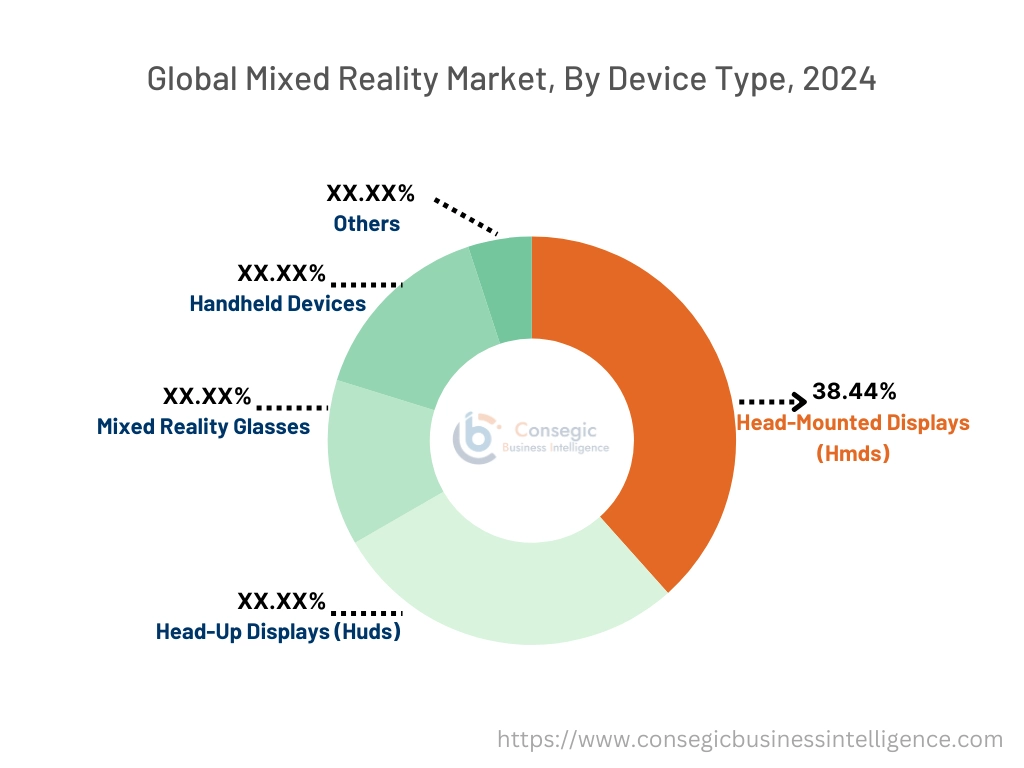
By Application:
Based on the application, the market is segmented into training & simulation, remote assistance, product design & prototyping, virtual collaboration, healthcare & surgery assistance, and others.
Trends in the Application:
- Rising demand and adoption of MR in remote assistance in various industries including healthcare, manufacturing, and education is boosting the mixed reality market size.
- Increasing trend in adoption of MR in product design and prototyping to visualize products in real-world context.
The training & simulation segment accounted for the largest revenue share in the mixed reality market share in 2024.
- The MR technology is used in training and simulation to create immersive learning experiences in a controlled and safe environment. This allows users to create simulation of complex scenarios for training purposes.
- For instance, in October 2024, DPVR launched P1 Pro Cam headset specifically designed for education and training. The MR headset enables teachers to enhance physical objects with digital content.
- Therefore, the increasing utilization of MR in training and simulation applications are boosting the mixed reality market expansion.
The virtual collaboration segment is expected to register the fastest CAGR during the forecast period.
- MR is used in virtual collaboration to allow individuals in different locations to interact with both real and virtual world simultaneously.
- This creates more collaborative experience where users are able to see and manipulate objects in digital world while being in physically different locations.
- For instance, in January 2025, HTC VIVE and Virtualware collaborated to launch the first enterprise simulation lab. The partnership aims to enhance workforce development, learning, and industrial training using MR technology.
- Thus, the mixed reality market analysis depicts that the aforementioned factors are projected to boost the market during the forecast period.
By End-User:
Based on the end user, the market is segmented into aerospace and defense, automotive, e-commerce and retail, aerospace and defense, education, industrial and manufacturing, architecture, entertainment and gaming, medical, and others.
Trends in the End User:
- Rising trend in adoption of MR in gaming to enhance the immersive experience by interacting with the real and virtual world simultaneously.
- Increasing demand and adoption of MR in e-commerce allows consumers to check how a product looks or works in the environment.
The industrial and manufacturing segment accounted for the largest revenue in the mixed reality market share in 2024.
- In industrial and manufacturing segment, the MR technology is used for designing prototypes, data visualization, remote collaboration, quality assurance, human machine interface, and maintenance and repair.
- It improves equipment performance, efficiency, safety, and productivity due to reduced errors, and downtime.
- Therefore, the utilization of MR in industrial and manufacturing sector is boosting the mixed reality market expansion.
The medical segment is expected to register the fastest CAGR during the forecast period.
- MR is used in medical sector for various applications including visualization of person’s anatomy in 3D, remote care and consultation, medical training, advanced medical imaging, and mental health interventions, among others.
- For instance, in January 2025, Innovate UK launched its third funding offering up to £3.7 Million (USD 4.8 Million) for the UK-based projects that develop MR application in mental health segment. The initiative is named ‘Mindset Programme’ and aims to create efficient, scalable, and effective treatment options.
- Thus, the mixed reality market analysis depicts that the aforementioned factors are anticipated to drive the market during the forecast period.
Regional Analysis:
The regions covered are North America, Europe, Asia Pacific, the Middle East and Africa, and Latin America.
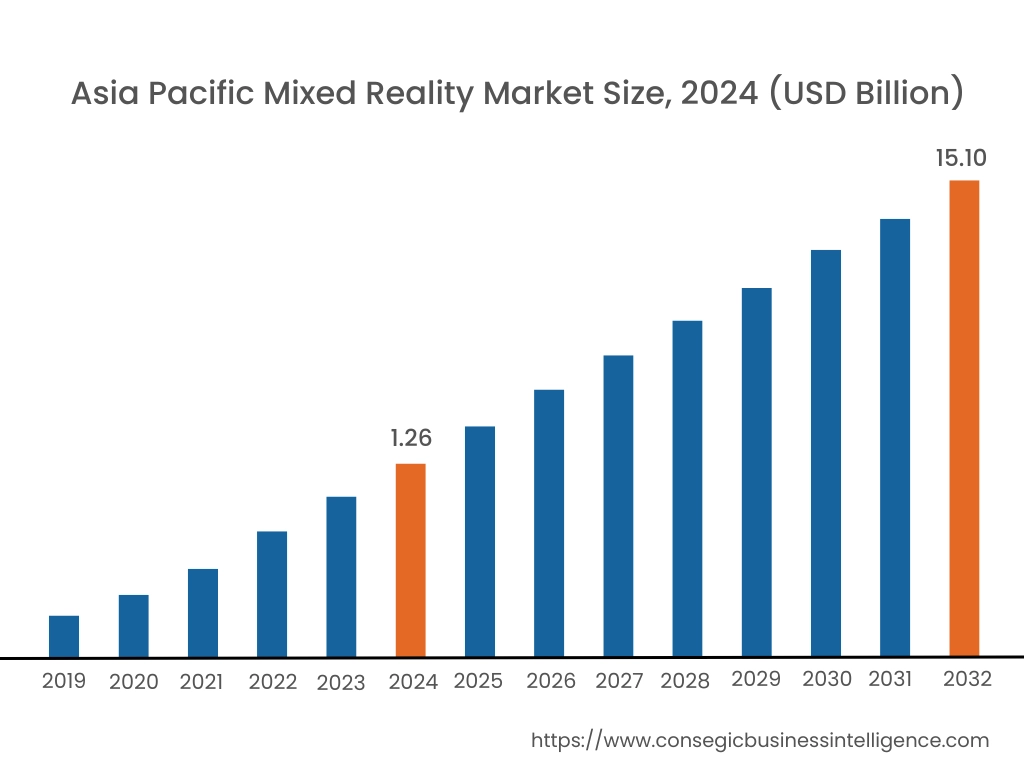
Asia Pacific region was valued at USD 1.26 Billion in 2024. Moreover, it is projected to grow by USD 1.69 Billion in 2025 and reach over USD 15.10 Billion by 2032. Out of this, China accounted for the maximum revenue share of 35.5%. The market in the Asia-Pacific region is driven by rising technological advancements in the industrial and manufacturing sectors. Moreover, the rising government initiates to promote advanced technologies is boosting the market growth.
- For instance, in February 2025, XRHealth, an Australia-based MR solution provider, acquired RealizedCare, a digital therapeutics company. The above factors are driving the market in the Asia-Pacific region.
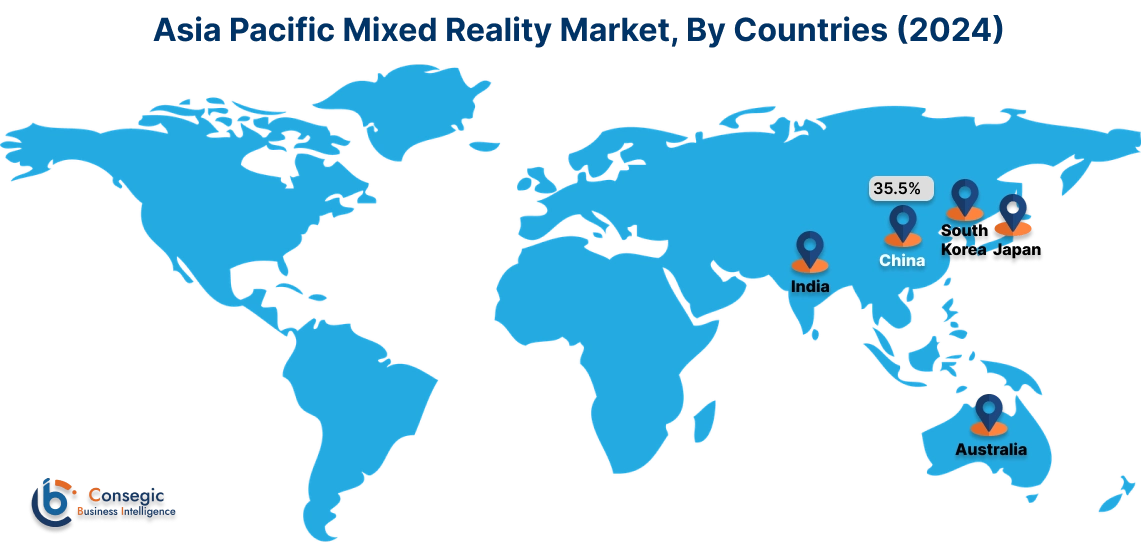
North America is estimated to reach over 20.28 Billion by 2032 from a value of USD 1.77 Billion in 2024 and is projected to grow by USD 2.37 Billion in 2025. The market in the region is driven by expanding healthcare, gaming, and education sector, which utilizes MR for training, simulation, surgery assistance, and others. Moreover, the rising applications of MR in aerospace and defense industry in the region are boosting the market growth.
- For instance, in February 2025, Anduril Industries and Microsoft partnered to work on the advanced phase of the U.S. Army’s Integrated Visual Augmentation System (IVAS) program.
Additionally, the market analysis depicts that the European market is driven by rising investments in MR technology in healthcare, gaming, and education sector. Further, Latin America, Middle East and Africa regions are driven by the wide applications and use-cases of MR in retail, manufacturing, and gaming sectors among others.
Top Key Players and Market Share Insights:
The mixed reality industry is highly competitive with major players providing solutions to the national and international markets. Key players are adopting several strategies in research and development (R&D), product innovation, and end-user launches to hold a strong position in the global mixed reality market. Key players in the mixed reality industry include -
- Accenture PLC (Ireland)
- Dell Technologies Inc. (US)
- Meta Company (US)
- Eon Reality Inc. (US)
- Google Inc. (US)
- HP Development Company LP (US)
- HTC Corporation (Taiwan)
- Intel Corporation (US)
- Magic Leap, Inc. (US)
- Microsoft Corporation (US)
- Occipital Inc. (US)
- Samsung Electronics Co. Ltd. (South Korea)
- Seiko Epson Corporation (Japan)
- Sony Corporation (Japan)
Recent Industry Developments :
Collaborations and Partnerships:
- In March 2025, DPVR partnered with Invelon as a distributor for Italy and Spain region. The partnership is aimed to bring DPVR’s MR and VR hardware to the region.
Mixed Reality Market Report Insights :
| Report Attributes | Report Details |
| Study Timeline | 2019-2032 |
| Market Size in 2032 | USD 54.52 Billion |
| CAGR (2025-2032) | 42.9% |
| By Component |
|
| By Device Type |
|
| By Application |
|
| By End-User |
|
| By Region |
|
| Key Players |
|
| North America | U.S. Canada Mexico |
| Europe | U.K. Germany France Spain Italy Russia Benelux Rest of Europe |
| APAC | China South Korea Japan India Australia ASEAN Rest of Asia-Pacific |
| Middle East and Africa | GCC Turkey South Africa Rest of MEA |
| LATAM | Brazil Argentina Chile Rest of LATAM |
| Report Coverage |
|
Key Questions Answered in the Report
How big is the mixed reality market? +
Mixed Reality Market size is estimated to reach over USD 54.52 Billion by 2032 from a value of USD 4.72 Billion in 2024 and is projected to grow by USD 6.33 Billion in 2025, growing at a CAGR of 42.9% from 2025 to 2032.
What are the major segments covered in the mixed reality market report? +
The segments covered in the report are component, device type, application, end user, and region.
Which region holds the largest revenue share in 2024 in the mixed reality market? +
North America holds the largest revenue share in the mixed reality market in 2024.
Who are the major key players in the mixed reality market? +
The major key players in the market are Accenture PLC (Ireland), Dell Technologies Inc. (US), Meta Company (US), Eon Reality Inc. (US), Google Inc. (US), HP Development Company LP (US), HTC Corporation (Taiwan), Intel Corporation (US), Magic Leap, Inc. (US), Microsoft Corporation (US), Occipital Inc. (US), Samsung Electronics Co. Ltd. (South Korea), Seiko Epson Corporation (Japan), and Sony Corporation (Japan).
